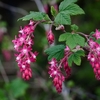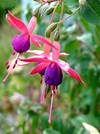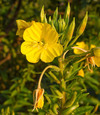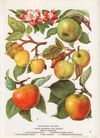Taxa/Terms Quiz COPY Flashcards

Tropaeolaceae; Tropaeolum ~90 sp: (Garden nasturtium)
Climbing herbs with orbicular,
Lvs: peltate leaves and twining petioles
Corolla: Brightly colored zygomorphic flowers:
FF: 5 sepals, 5 petals, 8 stamens, 3 connate carpels Prominent nectar spur extends from the upper-most sepal
Fruit: Fruit breaks into three single-seeded sections at maturity (schizocarp)
Other info: Foliage and flowers add a pleasant peppery accent to salads [related to the mustard family and deploying the same kind of secondary chemistry defense system]
Note: this is a genus of about 90 species, some of which have deeply palmately lobed leaves and rather different looking flowers – try “google imaging” examples of some of these.
Family: Ericaceae
Genus: Vaccinium
Characteristics:
1’ Deciduous
3’ Entire lf; Calyx lobes
Ericaceae (Family)
Genus… (V.)
Species ()

Vaccinium Parvifolium
CN: Red Huckleberry
1’ Leaves deciduous (rarely evergreen in young plants of Vaccinium parvifolium), thin or ± thick, veins generally prominent abaxially; pedicel not jointed to flower; filaments glabrous
3’ Leaf serrate or minutely so (but see Vaccinium parvifolium); calyx lobes ± 0 or generally < tube, deciduous; twigs angled or not, green or not; flowers often 1 in axils of lowest leaves of youngest shoots
4’ Twigs strongly angled, green; fruit red to dark blue or purple
7’ Leaf margins flat, generally not ciliate; berry red, not glaucous; hypanthium scar to 1/2 width of berry.
- Plant erect shrub, 10–40 dm, generally not rhizomed; leaf entire to serrate or with only deciduous, sharp point at tip, abaxially (especially midvein) puberulent ….. V. parvifolium
Ericaceae (Family)
Genus… (V.)
Species ()

Vaccinium ovatum
CN: California Huckleberry/Black Huckleberry
- Leaves evergreen, leathery, veins not prominent abaxially; pedicel
jointed to flower; filaments ± hairy
2’ Plant 5–30 dm, branches stout; leaf 20–50 mm,
serrate ; corolla lobes < tube, erect to spreading when anthers open …..
V. ovatum

Alliaceae (Allium) “Onion Family” Sp. Allium (Onion)
Fruit: Bulb
Inflorescence: Umbel inflorescence; Scapose, Inflorescence bract, spathe
Corolla: Tepals
FF: 3,3,6,3
Similar to Lily!


Family Iridaceae “Iris Family” Sp. Iris
*,3,3,3,3
Inferior ovary
3 stamen capsule
Equitant leaves
Erect “banner-like” petals

Family ranunculaceae (Buttercup family) Ranunculus Genera
Habit: Ann/per herb (1 exception: clematis =woods) basal and cauline
Leaf arch: ternate (ternately lobed/compound)
Base of petiole flat->arranged in 3’s “clasps the stem”
Flower: apocarpous gynoecium
Many stamen
Hooked tips on pistils (fruits)
Fruit: achenes (many carpels) follicles (several carpels)
Leaf Arch: ternately lobed (dissected/compound)
Symmetry: Radial
Perianth: 5,5
Nectar dispenser: flap at base of each petal

Delphinium (Genera) CN:larkspur
Leaf Arch: ternately (palmately) lobed
Symmetry: bilateral
Perianth: 5,4
Nectar dispenser: 2 nectar-secreting petals housed in a tubular sepal
FF: X, 5,4, many, 3
Sepals petal-like and showy UPPER 1st SEPAL IS SPURRED)
2 nectar secreting petals and 2 guard petal to protect sexual whorls

Aquilegia (Genus) CN: Columbine
Leaf Arch: ternately (palmately) lobed
Symmetry: Radial
Perianth: 5,5
Nectar dispenser: 5 tubular petals
All petals are spurred!!
Hummingbird dispersal
follicles!

Nymphaea (Family) CN: Water lilys
Long horizontal rhizome underground
Long leaf petiole
Large flowers with many parts
Attract beetles
Basal angiosperms
Genus
& CN

Penstemon(Beard’s tongue)
Habit: perennial herb, shrub
Leaf Arch: Simple leaves (lanceolate, elliptical)
Distal sessile
Generally opposite
Flower:
X,5,5,4+1,2
Capitate stigma
Fruit: Capsule
Family
CN

Family Plantaginaceae
Plantago (Plantains)
Habit: Scapose herbs
Leaf Arch: Simple, basal leaves w/ parallel venation
Infl/Flowers: reduced wind pollinated= Scarious
X,4,4,4,2
In dense spikes
Fruit: Capsule

FF: X,5^,3+2^,4,2
Habit: Annuals to shrubs (tree=Leak)
square/4 angled stems
Opposite leaves
Gen. pubescent/ gland dotted
Simple, gen. crenate/ dentate (serrate) margins
Flower:
Strongly zygomorphic
Bilabiate corolla
2 petals up
3 petals down
2 long 2 short stamen
Verticillaster-> Inflourescence of opposite cymes that occur in pairs creating a false whorl
Nototribic flowers-> pollen is deposited on the back of the visiting animal
Fruit: Gynobasic style w/ 4 lobed ovary
Schizocarp w/ 4 nutlets
Gynobasic-> style arising from the base of the ovary


Mimulus (Monkey flower)
Habit: annual to shrub
FF: X,5,5,2+2,2
Lf. Arch: simple, gen sessile, gen serrated
Occasionally glandular sticky/pubescent
Opposite
Flower:
Pleated calyx
Bilabiate
2 lobbed stigma sensitive to touch
Fruit: capsule


Habit: annual to shrub
FF: X,5,5,2+2,2
Inflorescence: raceme, bracted, fls 1-4 per node
Lf. Arch: entire, gen sessile, gen serrated
Occasionally glandular sticky/pubescent
Opposite
Flower:
- Pleated calyx
- Bilabiate
- 2 lobbed stigma sensitive to touch
Fruit: capsule


Erythranthe (mk fl)
Habit: annual or perennial herb, glabous herb
Lf: gen. Sessile, gen green or red
Inflorescence: raceme, bracted, or fls gen 2 per axil
Fr: capsule

Family Plantaginaceae “Plantain Family”
Plantago (Plantains)
FF: X,4,4,4,2
Habit: Scapose herbs
Leaf Arch: Simple, basal leaves w/ parallel venation
Infl/Flowers: reduced wind pollinated= Scarious
In dense spikes
Fruit: Capsule

Penstemon(Beard’s tongue)
Habit: perennial herb, shrub
Leaf Arch: Simple leaves (lanceolate, elliptical)
Distal sessile
Generally opposite
Flower: X,5,5,4+1,2
Capitate stigma
Fruit: Capsule


Family Aristolochiaceae “Pipevine Family” SP. Asarum
Asarum (Wild Ginger)
Habit: Herbaceous, perennial
Basal angiosperm
Fl:3-parted dark colored flowers; no petals, just sepals
Lvs: Cordate leaves
Rhizomatous
Ancient, not eudicot or monocot
Capsules in fr, protein packets for ants to help germinate



































